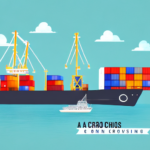Unlocking the Benefits of GRI Ocean Freight Shipping
In the realm of international trade, selecting the optimal mode of transportation is paramount. Among the myriad options available, GRI (Guaranteed Rate Increase) ocean freight shipping has emerged as a popular choice for businesses seeking cost-effective and efficient solutions. This comprehensive guide explores the advantages of GRI ocean freight shipping, delves into cost-saving opportunities, and outlines key factors to consider when opting for this transportation method.
Understanding the GRI Ocean Freight Shipping Model
GRI ocean freight shipping operates on a contract-based model where carriers and shippers agree on specific rates for a predetermined period. These rates are negotiated in advance and typically include a fixed percentage increase from the base rate. The primary objective of GRI is to offer carriers stable pricing and consistent volumes, while shippers gain clarity and predictability in their transportation costs.
It's essential to recognize that GRI rates are influenced by market conditions and may fluctuate based on factors such as fuel prices, demand, and shipping capacity. Additionally, shippers might face penalties if they fail to meet the agreed-upon volume commitments. Nonetheless, when managed effectively, GRI ocean freight shipping can be mutually beneficial for both carriers and shippers.
Key Features of GRI Contracts
- Fixed Rate Period: Rates remain stable for the duration of the contract, typically spanning several months to a year.
- Volume Commitments: Shippers agree to ship a minimum volume, ensuring consistent business for carriers.
- Rate Increases: Pre-negotiated rate hikes provide predictability in long-term budgeting.
Advantages Over Traditional Ocean Freight Methods
GRI ocean freight shipping offers several benefits compared to traditional spot shipping methods:
Predictable and Stable Pricing
Traditional shipping rates are susceptible to frequent fluctuations, making budgeting challenging for shippers. In contrast, GRI contracts lock in rates for the contract period, providing financial predictability and allowing businesses to plan their logistics budgets more accurately.
Consistent Shipment Volumes
GRI agreements ensure consistent shipment volumes, which can enhance service levels and reliability. Carriers benefit from predictable workloads, leading to better resource management and improved operational efficiencies.
Enhanced Transparency and Tracking
Many GRI carriers employ advanced tracking technologies, offering real-time visibility into shipment statuses. This transparency aids shippers in better coordinating their supply chain operations and mitigating potential delays.
Environmental Sustainability
GRI ocean freight shipping often emphasizes sustainability, with carriers adopting fuel-efficient vessels and implementing measures to reduce carbon emissions. This commitment not only benefits the environment but also enhances the corporate social responsibility profiles of shippers.
Cost Savings with GRI Ocean Freight Shipping
GRI contracts can lead to significant cost savings for businesses through various mechanisms:
Lower Negotiated Rates
By locking in rates ahead of time, shippers can secure lower prices compared to fluctuating spot rates. This strategy can result in substantial savings, especially for businesses with consistent shipping volumes.
Avoidance of Last-Minute Fees
Stable GRI rates help avoid unexpected costs associated with last-minute bookings, such as rush fees or premium surcharges.
Consolidation Services
GRI carriers often offer consolidation services, allowing multiple shipments to be combined into a single container. This approach reduces the cost per shipment by distributing transportation expenses across multiple clients.
Key Considerations When Choosing GRI Shipping
Before committing to a GRI ocean freight contract, businesses should assess several critical factors:
Type and Volume of Cargo
GRI contracts are best suited for shippers with consistent and sizable shipment volumes. Businesses with fluctuating or minimal shipping needs might find traditional methods more adaptable.
Contract Duration
Shippers should evaluate whether they are comfortable committing to the duration of a GRI contract, typically ranging from six months to a year, and assess their long-term shipping needs.
Carrier Network and Service Quality
Assessing the carrier's network reach, reliability, and service quality is essential to ensure they align with the business's logistical requirements.
Total Cost Comparison
Shippers should perform a comprehensive cost analysis comparing GRI rates with spot rates and other shipping options to determine the most economical choice for their specific needs.
Environmental Impact
Evaluating a carrier's sustainability practices can help businesses align their shipping choices with their environmental goals.
The Role of Technology and Sustainability in GRI Shipping
Technology and sustainability play pivotal roles in enhancing the efficiency and environmental responsibility of GRI ocean freight shipping:
Advanced Tracking Systems
Implementing Electronic Data Interchange (EDI) and other digital tools streamlines booking, tracking, and invoicing processes, reducing errors and improving communication between shippers and carriers.
Real-Time Shipment Visibility
Technology provides shippers with real-time data on shipment locations and statuses, enabling proactive supply chain management and timely decision-making.
Fuel-Efficient Vessels
GRI carriers prioritize fuel-efficient ships and adopt measures to minimize emissions, contributing to reduced carbon footprints and adherence to environmental regulations.
Digital Security Measures
Enhanced security protocols protect shipment data and prevent theft or loss, ensuring the integrity and safety of the cargo throughout transit.
Future Trends and Predictions in GRI Ocean Freight Shipping
The landscape of GRI ocean freight shipping is continuously evolving. Emerging trends expected to shape its future include:
Increased Flexibility in Contracts
Future GRI contracts may offer greater flexibility in duration and volume commitments, catering to the dynamic needs of modern businesses.
Enhanced Sustainability Initiatives
With growing environmental concerns, carriers are likely to adopt more rigorous sustainability practices, such as transitioning to greener fuels and investing in eco-friendly technologies.
Integration with E-Commerce
The surge in e-commerce demand is prompting GRI shipping solutions to adapt, offering more scalable and responsive services to support online retailers' global distribution networks.
Automation and Artificial Intelligence
Advancements in automation and AI are expected to optimize shipping operations, from route planning to predictive maintenance, further enhancing efficiency and reliability.
Conclusion
GRI ocean freight shipping presents a strategic option for businesses aiming to optimize their supply chains with predictable costs and reliable service. By understanding the GRI model, leveraging its benefits, and considering key factors before implementation, shippers can achieve significant efficiencies and cost savings. Additionally, embracing technological advancements and sustainability initiatives will further enhance the value proposition of GRI ocean freight shipping in the ever-evolving global trade landscape.






















